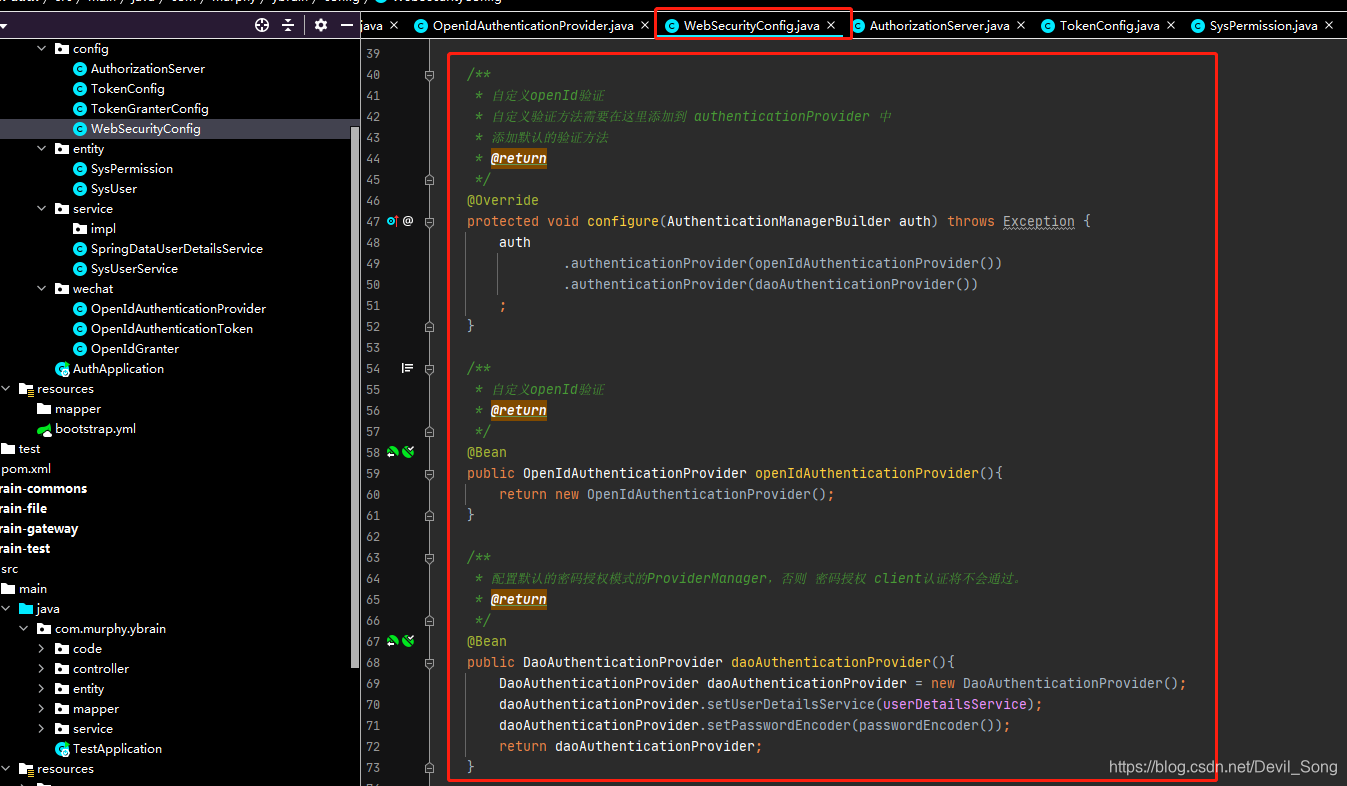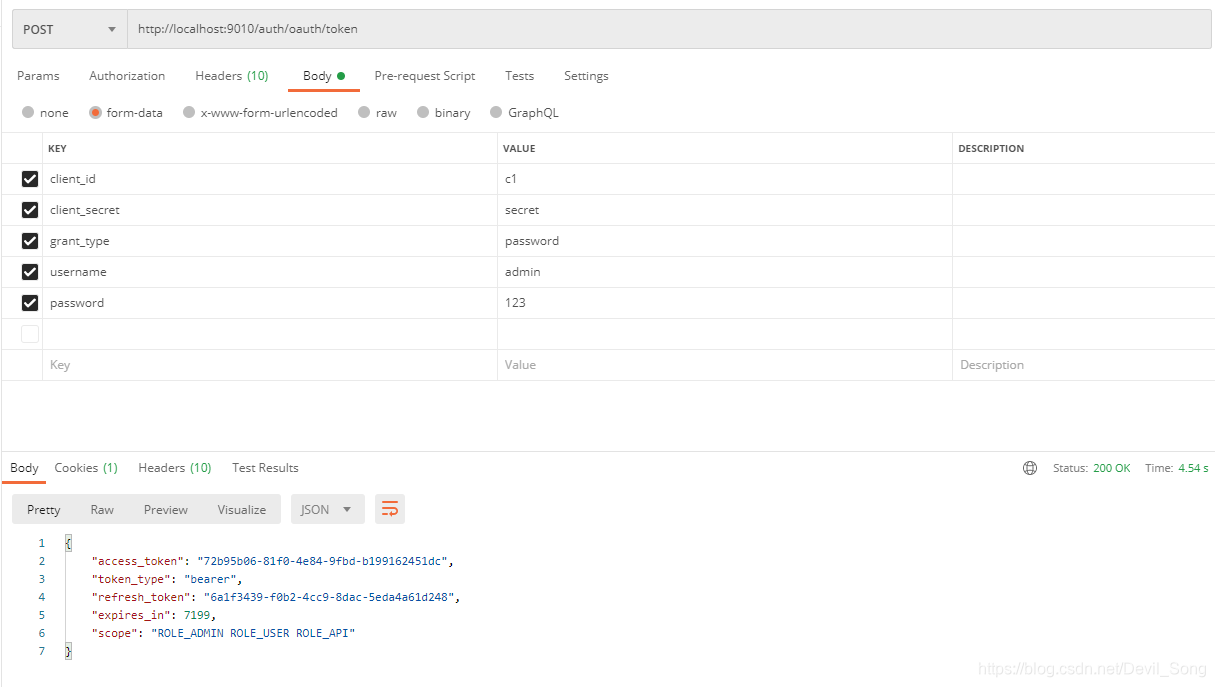
通过密码模式授权流程分析可以知道以下两部分内容:
第一部分:关于授权类型 grant_type 的解析
- 每种 grant_type 都会有一个对应的 TokenGranter 实现类。
- 所有 TokenGranter 实现类都通过 CompositeTokenGranter 中的 tokenGranters 集合存起来。
- 然后通过判断 grantType 参数来定位具体使用那个 TokenGranter 实现类来处理授权。
第二部分:关于授权登录逻辑
- 每种 授权方式 都会有一个对应的 AuthenticationProvider 实现类来实现。
- 所有 AuthenticationProvider 实现类都通过 ProviderManager 中的 providers 集合存起来。
- TokenGranter 类会 new 一个 AuthenticationToken 实现类,如 UsernamePasswordAuthenticationToken 传给 ProviderManager 类。
- 而 ProviderManager 则通过 AuthenticationToken 来判断具体使用那个 AuthenticationProvider 实现类来处理授权。
- 具体的登录逻辑由 AuthenticationProvider 实现类来实现,如 DaoAuthenticationProvider。
通过以上分析,实现自定义授权方式获取token需要完成以下三个主要内容:
- 定义一个新的 grantType 类型,并新增对应的 TokenGranter 实现类添加到 CompositeTokenGranter 中的 tokenGranters 集合里
- 新增一个 AuthenticationToken 实现类,用于存放该授权所需的信息。
- 新增一个 AuthenticationProvider 实现类 实现授权的逻辑,并重写 supports 方法绑定步骤二的 AuthenticationToken 实现类
创建
新增一个 TokenGranter 实现类 OpenIdGranter 继承 AbstractTokenGranter
import org.springframework.security.authentication.AbstractAuthenticationToken;
import org.springframework.security.authentication.AuthenticationManager;
import org.springframework.security.core.Authentication;
import org.springframework.security.oauth2.common.exceptions.InvalidGrantException;
import org.springframework.security.oauth2.provider.*;
import org.springframework.security.oauth2.provider.token.AbstractTokenGranter;
import org.springframework.security.oauth2.provider.token.AuthorizationServerTokenServices;
import java.util.LinkedHashMap;
import java.util.Map;
/**
* @author Murphy
* @date 2020-12-19 11:52
*/
public class OpenIdGranter extends AbstractTokenGranter {
private static final String GRANT_TYPE = "openId";
private final AuthenticationManager authenticationManager;
public OpenIdGranter(AuthenticationManager authenticationManager, AuthorizationServerTokenServices tokenServices
, ClientDetailsService clientDetailsService, OAuth2RequestFactory requestFactory) {
super(tokenServices, clientDetailsService, requestFactory, GRANT_TYPE);
this.authenticationManager = authenticationManager;
}
@Override
protected OAuth2Authentication getOAuth2Authentication(ClientDetails client, TokenRequest tokenRequest) {
Map<String, String> parameters = new LinkedHashMap<>(tokenRequest.getRequestParameters());
String openId = parameters.get("openId");
Authentication userAuth = new OpenIdAuthenticationToken(openId);
((AbstractAuthenticationToken) userAuth).setDetails(parameters);
userAuth = authenticationManager.authenticate(userAuth);
if (userAuth == null || !userAuth.isAuthenticated()) {
throw new InvalidGrantException("Could not authenticate openId: " + openId);
}
OAuth2Request storedOAuth2Request = getRequestFactory().createOAuth2Request(client, tokenRequest);
return new OAuth2Authentication(storedOAuth2Request, userAuth);
}
}
新增一个 AuthenticationToken 实现类 OpenIdAuthenticationToken,用于存放该授权所需的信息。
由于实际情况,服务端和客户端是两个服务,该类必须放在公共包下面。否则在客户端调用接口token验证会报 序列化错误 Failed to deserialize authentication for 你的token ,异常为 找不到OpenIdAuthenticationToken.class。
import org.springframework.security.authentication.AbstractAuthenticationToken;
import org.springframework.security.core.GrantedAuthority;
import org.springframework.security.core.SpringSecurityCoreVersion;
import java.util.Collection;
/**
* @author Murphy
* @date 2020-12-19 11:56
* 需要放在公共的包下面
*/
public class OpenIdAuthenticationToken extends AbstractAuthenticationToken {
private static final long serialVersionUID = SpringSecurityCoreVersion.SERIAL_VERSION_UID;
// ~ Instance fields
// ================================================================================================
private final Object principal;
// ~ Constructors
// ===================================================================================================
/**
* This constructor can be safely used by any code that wishes to create a
* <code>UsernamePasswordAuthenticationToken</code>, as the {@link #isAuthenticated()}
* will return <code>false</code>.
*
*/
public OpenIdAuthenticationToken(String openId) {
super(null);
this.principal = openId;
setAuthenticated(false);
}
/**
* This constructor should only be used by <code>AuthenticationManager</code> or
* <code>AuthenticationProvider</code> implementations that are satisfied with
* producing a trusted (i.e. {@link #isAuthenticated()} = <code>true</code>)
* authentication token.
*
* @param principal
* @param authorities
*/
public OpenIdAuthenticationToken(Object principal,
Collection<? extends GrantedAuthority> authorities) {
super(authorities);
this.principal = principal;
super.setAuthenticated(true);
}
// ~ Methods
// ========================================================================================================
@Override
public Object getCredentials() {
return null;
}
@Override
public Object getPrincipal() {
return this.principal;
}
@Override
public void setAuthenticated(boolean isAuthenticated) {
if (isAuthenticated) {
throw new IllegalArgumentException(
"Cannot set this token to trusted - use constructor which takes a GrantedAuthority list instead");
}
super.setAuthenticated(false);
}
@Override
public void eraseCredentials() {
super.eraseCredentials();
}
}
新增一个 AuthenticationProvider 实现类 OpenIdAuthenticationProvider 实现授权的逻辑
import com.murphy.ybrain.service.SpringDataUserDetailsService;
import lombok.Setter;
import org.springframework.beans.factory.annotation.Autowired;
import org.springframework.security.authentication.AuthenticationProvider;
import org.springframework.security.authentication.InternalAuthenticationServiceException;
import org.springframework.security.core.Authentication;
import org.springframework.security.core.userdetails.UserDetails;
import org.springframework.security.core.userdetails.UserDetailsService;
/**
* @author Murphy
* @date 2020-12-19 11:53
*/
@Setter
public class OpenIdAuthenticationProvider implements AuthenticationProvider {
@Autowired
private UserDetailsService userDetailsService;
@Autowired
private SpringDataUserDetailsService springDataUserDetailsService;
@Override
public Authentication authenticate(Authentication authentication) {
OpenIdAuthenticationToken authenticationToken = (OpenIdAuthenticationToken) authentication;
String openId = (String) authenticationToken.getPrincipal();
// 调用自定义的通过openId获取用户信息方法
UserDetails user = springDataUserDetailsService.loadUserByOpenId(openId);
if (null == user) {
throw new InternalAuthenticationServiceException("openId错误");
}
OpenIdAuthenticationToken authenticationResult = new OpenIdAuthenticationToken(user, user.getAuthorities());
authenticationResult.setDetails(authenticationToken.getDetails());
return authenticationResult;
}
@Override
public boolean supports(Class<?> authentication) {
return OpenIdAuthenticationToken.class.isAssignableFrom(authentication);
}
public UserDetailsService getUserDetailsService() {
return userDetailsService;
}
public void setUserDetailsService(UserDetailsService userDetailsService) {
this.userDetailsService = userDetailsService;
}
}
新增 TokenGranterConfig 类 配置自定义授权模式
import com.murphy.ybrain.wechat.OpenIdGranter;
import org.springframework.beans.factory.annotation.Autowired;
import org.springframework.context.annotation.Bean;
import org.springframework.context.annotation.Configuration;
import org.springframework.security.authentication.AuthenticationManager;
import org.springframework.security.authentication.ProviderManager;
import org.springframework.security.core.userdetails.UserDetailsByNameServiceWrapper;
import org.springframework.security.core.userdetails.UserDetailsService;
import org.springframework.security.oauth2.common.OAuth2AccessToken;
import org.springframework.security.oauth2.provider.*;
import org.springframework.security.oauth2.provider.client.ClientCredentialsTokenGranter;
import org.springframework.security.oauth2.provider.code.AuthorizationCodeServices;
import org.springframework.security.oauth2.provider.code.AuthorizationCodeTokenGranter;
import org.springframework.security.oauth2.provider.code.InMemoryAuthorizationCodeServices;
import org.springframework.security.oauth2.provider.code.RandomValueAuthorizationCodeServices;
import org.springframework.security.oauth2.provider.implicit.ImplicitTokenGranter;
import org.springframework.security.oauth2.provider.password.ResourceOwnerPasswordTokenGranter;
import org.springframework.security.oauth2.provider.refresh.RefreshTokenGranter;
import org.springframework.security.oauth2.provider.request.DefaultOAuth2RequestFactory;
import org.springframework.security.oauth2.provider.token.*;
import org.springframework.security.web.authentication.preauth.PreAuthenticatedAuthenticationProvider;
import java.util.ArrayList;
import java.util.Collections;
import java.util.List;
/**
* @author Murphy
* @date 2020-12-19 12:03
*
* 配置自定义授权模式
*
*/
@Configuration
public class TokenGranterConfig {
@Autowired
private ClientDetailsService clientDetailsService;
@Autowired
private UserDetailsService userDetailsService;
@Autowired
private AuthenticationManager authenticationManager;
@Autowired
private TokenStore tokenStore;
@Autowired(required = false)
private List<TokenEnhancer> tokenEnhancer;
@Autowired
private RandomValueAuthorizationCodeServices authorizationCodeServices;
private boolean reuseRefreshToken = true;
private AuthorizationServerTokenServices tokenServices;
private TokenGranter tokenGranter;
/**
* 授权模式
*/
@Bean
public TokenGranter tokenGranter() {
if (tokenGranter == null) {
tokenGranter = new TokenGranter() {
private CompositeTokenGranter delegate;
@Override
public OAuth2AccessToken grant(String grantType, TokenRequest tokenRequest) {
if (delegate == null) {
delegate = new CompositeTokenGranter(getAllTokenGranters());
}
return delegate.grant(grantType, tokenRequest);
}
};
}
return tokenGranter;
}
/**
* 所有授权模式:默认的5种模式 + 自定义的模式
*/
private List<TokenGranter> getAllTokenGranters() {
AuthorizationServerTokenServices tokenServices = tokenServices();
AuthorizationCodeServices authorizationCodeServices = authorizationCodeServices();
OAuth2RequestFactory requestFactory = requestFactory();
//获取默认的授权模式
List<TokenGranter> tokenGranters = getDefaultTokenGranters(tokenServices, authorizationCodeServices, requestFactory);
if (authenticationManager != null) {
// 添加openId模式
tokenGranters.add(new OpenIdGranter(authenticationManager, tokenServices, clientDetailsService, requestFactory));
}
return tokenGranters;
}
/**
* 默认的授权模式
*/
private List<TokenGranter> getDefaultTokenGranters(AuthorizationServerTokenServices tokenServices
, AuthorizationCodeServices authorizationCodeServices, OAuth2RequestFactory requestFactory) {
List<TokenGranter> tokenGranters = new ArrayList<>();
// 添加授权码模式
tokenGranters.add(new AuthorizationCodeTokenGranter(tokenServices, authorizationCodeServices, clientDetailsService, requestFactory));
// 添加刷新令牌的模式
tokenGranters.add(new RefreshTokenGranter(tokenServices, clientDetailsService, requestFactory));
// 添加隐士授权模式
tokenGranters.add(new ImplicitTokenGranter(tokenServices, clientDetailsService, requestFactory));
// 添加客户端模式
tokenGranters.add(new ClientCredentialsTokenGranter(tokenServices, clientDetailsService, requestFactory));
if (authenticationManager != null) {
// 添加密码模式
tokenGranters.add(new ResourceOwnerPasswordTokenGranter(authenticationManager, tokenServices, clientDetailsService, requestFactory));
}
return tokenGranters;
}
private AuthorizationServerTokenServices tokenServices() {
if (tokenServices != null) {
return tokenServices;
}
this.tokenServices = createDefaultTokenServices();
return tokenServices;
}
private AuthorizationCodeServices authorizationCodeServices() {
if (authorizationCodeServices == null) {
authorizationCodeServices = new InMemoryAuthorizationCodeServices();
}
return authorizationCodeServices;
}
private OAuth2RequestFactory requestFactory() {
return new DefaultOAuth2RequestFactory(clientDetailsService);
}
private DefaultTokenServices createDefaultTokenServices() {
DefaultTokenServices tokenServices = new DefaultTokenServices();
tokenServices.setTokenStore(tokenStore);
tokenServices.setSupportRefreshToken(true);
tokenServices.setReuseRefreshToken(reuseRefreshToken);
tokenServices.setClientDetailsService(clientDetailsService);
tokenServices.setTokenEnhancer(tokenEnhancer());
addUserDetailsService(tokenServices, this.userDetailsService);
return tokenServices;
}
private TokenEnhancer tokenEnhancer() {
if (tokenEnhancer != null) {
TokenEnhancerChain tokenEnhancerChain = new TokenEnhancerChain();
tokenEnhancerChain.setTokenEnhancers(tokenEnhancer);
return tokenEnhancerChain;
}
return null;
}
private void addUserDetailsService(DefaultTokenServices tokenServices, UserDetailsService userDetailsService) {
if (userDetailsService != null) {
PreAuthenticatedAuthenticationProvider provider = new PreAuthenticatedAuthenticationProvider();
provider.setPreAuthenticatedUserDetailsService(new UserDetailsByNameServiceWrapper<>(userDetailsService));
tokenServices.setAuthenticationManager(new ProviderManager(Collections.singletonList(provider)));
}
}
}
到此 主要的内容我们已经完成了,下面还需要进行一些细节的配置。
把自定义的OpenIdAuthenticationProvider 放入ProviderManager集合中,我的方法如下,在配置文件中,重写configure方法,配置ProviderManager,这里除了配置我们自定义的ProviderManager之外,还需要额外配置默认的密码授权模式的ProviderManager,否则client认证将不会通过。

import com.murphy.ybrain.wechat.OpenIdAuthenticationProvider;
import org.springframework.beans.factory.annotation.Autowired;
import org.springframework.context.annotation.Bean;
import org.springframework.context.annotation.Configuration;
import org.springframework.security.authentication.AuthenticationManager;
import org.springframework.security.authentication.dao.DaoAuthenticationProvider;
import org.springframework.security.config.annotation.authentication.builders.AuthenticationManagerBuilder;
import org.springframework.security.config.annotation.method.configuration.EnableGlobalMethodSecurity;
import org.springframework.security.config.annotation.web.builders.HttpSecurity;
import org.springframework.security.config.annotation.web.configuration.WebSecurityConfigurerAdapter;
import org.springframework.security.core.userdetails.UserDetailsService;
import org.springframework.security.crypto.bcrypt.BCryptPasswordEncoder;
import org.springframework.security.crypto.password.PasswordEncoder;
/**
* @author Murphy
* @date 2020-12-10 9:52
*/
@Configuration
@EnableGlobalMethodSecurity(securedEnabled = true,prePostEnabled = true)
public class WebSecurityConfig extends WebSecurityConfigurerAdapter {
@Autowired
private UserDetailsService userDetailsService;
//密码编码器
@Bean
public PasswordEncoder passwordEncoder() {
return new BCryptPasswordEncoder();
}
//认证管理器
@Bean
public AuthenticationManager authenticationManagerBean() throws Exception {
return super.authenticationManagerBean();
}
/**
* 自定义openId验证
* 自定义验证方法需要在这里添加到 authenticationProvider 中
* 添加默认的验证方法
* @return
*/
@Override
protected void configure(AuthenticationManagerBuilder auth) throws Exception {
auth
.authenticationProvider(openIdAuthenticationProvider())
.authenticationProvider(daoAuthenticationProvider())
;
}
/**
* 自定义openId验证
* @return
*/
@Bean
public OpenIdAuthenticationProvider openIdAuthenticationProvider(){
return new OpenIdAuthenticationProvider();
}
/**
* 配置默认的密码授权模式的ProviderManager,否则 密码授权 client认证将不会通过。
* @return
*/
@Bean
public DaoAuthenticationProvider daoAuthenticationProvider(){
DaoAuthenticationProvider daoAuthenticationProvider = new DaoAuthenticationProvider();
daoAuthenticationProvider.setUserDetailsService(userDetailsService);
daoAuthenticationProvider.setPasswordEncoder(passwordEncoder());
return daoAuthenticationProvider;
}
//安全拦截机制(最重要)
@Override
protected void configure(HttpSecurity http) throws Exception {
http.csrf().disable()
.authorizeRequests()
.antMatchers("/r/rq").hasAnyAuthority("p1")
.antMatchers("/login*").permitAll()
.anyRequest().authenticated()
.and()
.formLogin()
;
}
}
配置授权模式 默认的5种模式 + 自定义的模式

import org.springframework.beans.factory.annotation.Autowired;
import org.springframework.context.annotation.Bean;
import org.springframework.context.annotation.Configuration;
import org.springframework.http.HttpMethod;
import org.springframework.security.authentication.AuthenticationManager;
import org.springframework.security.crypto.password.PasswordEncoder;
import org.springframework.security.oauth2.config.annotation.configurers.ClientDetailsServiceConfigurer;
import org.springframework.security.oauth2.config.annotation.web.configuration.AuthorizationServerConfigurerAdapter;
import org.springframework.security.oauth2.config.annotation.web.configuration.EnableAuthorizationServer;
import org.springframework.security.oauth2.config.annotation.web.configurers.AuthorizationServerEndpointsConfigurer;
import org.springframework.security.oauth2.config.annotation.web.configurers.AuthorizationServerSecurityConfigurer;
import org.springframework.security.oauth2.provider.ClientDetailsService;
import org.springframework.security.oauth2.provider.TokenGranter;
import org.springframework.security.oauth2.provider.client.JdbcClientDetailsService;
import org.springframework.security.oauth2.provider.code.AuthorizationCodeServices;
import org.springframework.security.oauth2.provider.code.JdbcAuthorizationCodeServices;
import org.springframework.security.oauth2.provider.token.AuthorizationServerTokenServices;
import org.springframework.security.oauth2.provider.token.DefaultTokenServices;
import org.springframework.security.oauth2.provider.token.TokenStore;
import javax.sql.DataSource;
/**
* @author Murphy
* @date 2020-12-09 17:44
*/
@Configuration
@EnableAuthorizationServer
public class AuthorizationServer extends AuthorizationServerConfigurerAdapter {
@Autowired
private TokenStore tokenStore;
@Autowired
private ClientDetailsService clientDetailsService;
@Autowired
private AuthorizationCodeServices authorizationCodeServices;
@Autowired
private AuthenticationManager authenticationManager;
@Autowired
private TokenGranter tokenGranter;
@Autowired
private PasswordEncoder passwordEncider;
/**
* 令牌管理服务
* @return
*/
@Bean
public AuthorizationServerTokenServices tokenService(){
DefaultTokenServices services = new DefaultTokenServices();
services.setClientDetailsService(clientDetailsService); // 客户端信息服务
services.setSupportRefreshToken(true); // 是否产生刷新令牌
services.setTokenStore(tokenStore); // 令牌存储策略
services.setAccessTokenValiditySeconds(7200); // 令牌默认有效期2个小时
services.setRefreshTokenValiditySeconds(259200); // 刷新令牌默认有效期3天
return services;
}
/**
* 设置授权码模式的授权码如何存取,存储数据库
* @param dataSource
* @return
*/
@Bean
public AuthorizationCodeServices authorizationCodeServices(DataSource dataSource){
return new JdbcAuthorizationCodeServices(dataSource);
}
/**
* 将客户端信息存储到数据库
* @param dataSource
* @return
*/
@Bean
public ClientDetailsService clientDetailsService(DataSource dataSource){
ClientDetailsService clientDetailsService = new JdbcClientDetailsService(dataSource);
((JdbcClientDetailsService)clientDetailsService).setPasswordEncoder(passwordEncider);
return clientDetailsService;
}
/**
* 配置客户端详细信息服务
* @param clients
* @throws Exception
*/
@Override
public void configure(ClientDetailsServiceConfigurer clients) throws Exception {
clients.withClientDetails(clientDetailsService);
}
/**
* 令牌访问端点的安全策略
* @param security
* @throws Exception
*/
@Override
public void configure(AuthorizationServerSecurityConfigurer security) throws Exception {
security
.tokenKeyAccess("permitAll()") // oauth/token_key 公开
.checkTokenAccess("permitAll()") // oauth/check_token 公开
.allowFormAuthenticationForClients() // 表单认证,申请令牌
;
}
/**
* 令牌访问端点
* @param endpoints
* @throws Exception
*/
@Override
public void configure(AuthorizationServerEndpointsConfigurer endpoints) throws Exception {
endpoints
.tokenGranter(tokenGranter) // 配置授权模式 默认的5种模式 + 自定义的模式
.authenticationManager(authenticationManager) // 密码模式需要 认证管理器
.authorizationCodeServices(authorizationCodeServices) // 授权码模式需要 授权码服务
.tokenServices(tokenService()) // 令牌管理服务
.allowedTokenEndpointRequestMethods(HttpMethod.POST) // 允许POST提交
;
}
}
至此 自定义openId授权方式获取token已经完成了。
测试 账号密码登录:

测试 openId 登录:

该项目 Git 地址:
https://github.com/bohaosong/ybrain-auth
本文参考以下文章所写:
https://blog.youkuaiyun.com/weixin_42271016/article/details/104212326
https://www.cnblogs.com/zlt2000/p/13600371.html





 本文围绕密码模式授权流程展开分析,包括授权类型解析和授权登录逻辑。在此基础上,介绍了实现自定义授权方式获取token的主要内容,如定义新grantType、新增相关实现类等,还提及细节配置,最后完成自定义openId授权获取token并进行测试。
本文围绕密码模式授权流程展开分析,包括授权类型解析和授权登录逻辑。在此基础上,介绍了实现自定义授权方式获取token的主要内容,如定义新grantType、新增相关实现类等,还提及细节配置,最后完成自定义openId授权获取token并进行测试。
















 595
595










